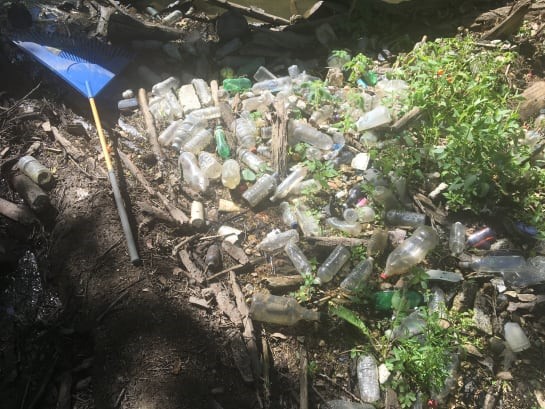The problem with plastics
Plastic is everywhere. According to the Washington Post, humans have produced more than 8 BILLION tons of plastic, mostly since the 1950’s, with less than 10% of that has been recycled. The Unites States generates more plastic trash that any other country.
According to American Rivers, The top items found during river cleanups includes cigarette butts, plastic bottles and caps, food packaging, and plastic bags. The Rouge is no exception. Each year during Rouge Rescue river cleanup efforts, a majority of items collected are made of plastic.

What are microplastics?
Microplastics are small pieces of plastic less than 5 millimeters in size.
Where do microplastics come from?
According to NOAA, plastic is the most prevalent type of marine debris found in our ocean and Great Lakes. Microplastics can be intentionally created for the use in production (primary microplastics) or come from larger pieces of plastic being broken down over time by sunlight and waves (secondary microplastics).
Microbeads are tiny pieces of polyethylene plastic that are added to health and beauty products, such as toothpastes or cleansers. Microbeads can also classify pellets used in plastic manufacturing.
Microfibers are synthetic, man-made materials used in clothing and textiles, such as polyester, acrylic and nylon. These products shed plastic particles when being worn or washed. Microfibers make up to 35% of primary plastic pollution in our oceans.
What are the effects of microplastics?
Plastic is very durable, that’s why we use it for so many things, but this attribute is the consequence. Plastic fragments over time don’t disappear, they just get smaller and can presumably persist for centuries.
Because these pieces are so small, they can make their way into a lot if things. Microplastics are so small, they can slip undetected through wastewater treatment plants too.
The full extent of microplastic impacts are unknown, but is an emerging field of study.
These small plastic pieces make their way into lakes, rivers and oceans which can contaminate our water, soil, food, and air. These tiny plastic bits have made their way to the deepest sea trenches, the highest mountains and are even part of the dust that blows around the planet in the atmosphere.
Wildlife of all sizes can also ingest microplastics, mistaking them as food or unknowingly ingest them. This can move microplastics up the food chain to people.
Any plastic also contain chemicals that can leach out into our water or soil.
What can I do about microplastics?
REDUCE, REUSE, RECYCLE! The best way to fight against microplastics is to keep plastic out of the environment by reducing or refusing plastic items we purchase, reusing plastic products or containers, and recycling plastic items accepted by your local municipality or finding a new use for it. You can also help by picking up plastic litter where you see it and dispose of it properly before it breaks down in our environment. You can also join us for one of our cleanup events!
The United States banned the use of microbeads in cosmetic and personal care items. To find out what products you have that may contain microplastics, go to https://www.beatthemicrobead.org/product-lists/ and use their search function.
fibers- buy cotton or natural fiber clothes and be sure to